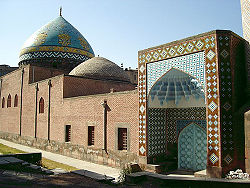Islam in Armenia

Islam in Armenia consists mostly of temporary residents from Iran and other contries. There is no native population reported as Muslim.
In 2009, the Pew Research Center estimated that less than 0.1% of the population, or about 1,000 people, were Muslims.[1] In the report it is said that the data for Armenia is taken from Armenia's 2000 Demographic and Health Survey, where there are no figures about Islam in Armenia.
Armenians did not convert to Islam in large numbers. During the Arabic conquest, Islam came to the Armenians however, almost all Armenians never converted to Islam, since Christians were not required to convert by Muslim law, although heavily taxed and discriminated. The story was different in the Ottoman Empire, where the people were forced to convert under the threat of death during and around the periods of Armenian Genocide and Hamidian Massacres and the women were forced into marriage with Muslim men and conversion.
During 1988-1991 the overwhelming majority of Muslim population consisting of Azeris and Muslim Kurds fled the country as a result of the Nagorno-Karabakh War and the ongoing conflict between Armenia and Azerbaijan. There is also a significant community of Yazidi Kurds (50-70,000 people), who were not affected by this conflict. Since the early 1990s, Armenia has also attracted diverse esoteric and sectarian groups. [2]
Arab invasions and Armenian revolts
| Islam by country |
|---|
 |
|
|
The Muslim Arabs first invaded Armenia in 640. Prince Theodoros Rshtuni led the Armenian defense. In about 652, a peace agreement was made, allowing Armenians freedom of religion. Prince Theodoros traveled to Damascus, where he was recognized by the Arabs as the ruler of Armenia, Georgia and Albania.[3] By the end of the seventh century, the Caliphate's policy toward Armenia and the Christian faith hardened due to various reasons. Special representatives of the Caliph called ostigans were sent to govern Armenia. The ostigans made the city of Dvin their residence. Before this Dvin was the residence of the Armenian Catholicos. [3]
Although declared the domain of the Caliph, most Armenians although not all remained faithful to the Christian religion. The Arabs failed in several attempts to convert the Armenians to Islam. The Armenian obstinacy exasperated caliph Abd al-Malik. In 705, he gave to one of the ostikans an unprecedented order to murder all Armenian Nakharars. More than 400 Armenian noblemen were entrapped in one of Nakhichevan churches, then the doors were closed and the church was set in fire. Later, the Arab historians termed that time as The Year of Great Burning. Quoting Pope John VI, "...ocean of tears flooded Armenia". A number of unsuccessful insurrections followed that tragic event during the 8th century.[3]
The Muslim population and monuments in Armenia
By the turn of the twentieth century, population of Yerevan, now the capital of Armenia, was over 29,000, of which 49% were Tatars (Turkic tribes) and Kurds, both nomadic or semi-nomadic, 48% Armenians and 2% Russians.[4] According to Brockhaus and Efron Encyclopedic Dictionary, at that time the town of Erivan had 7 Shia mosques. The Blue Mosque is the only one that remains in the present day Yerevan. In 1990 an Azerbaijani mosque in Yerevan was pulled down with a bulldozer.[5][6] Archaeologist Philip L. Kohl notes notes the "paucity of surviving Islamic remains in Armenia, including the capital of Yerevan". Citing the information on demography of Armenia before the Russian conquest, Kohl concludes:
No matter what demographic statistics one consults, it is simply unquestionable that considerable material remains of Islam must once have existed in this area. Their near total absence today cannot be fortuitous.[7]
The Qur'an
There were Qur'an (Armenian: Ղուրան, Ghuran) manuscripts translated into Classical Armenian, Grabar. However first printed version of Qur'an translated into Armenian language from Arabic appeared in 1910. In 1912 a translation from a French version was published. Both of them were in the Western Armenian dialect. A new translation of the Qur'an in Eastern Armenian dialect was started with the help of the Islamic Republic of Iran embassy in Yerevan. The translation was done by Edvard Hakhverdyan from Persian in three years[8]. A group of Arabologists have been helping with the translation. Each of the 30 parts of Qur'an have been read and approved by the Tehran Center of Qur'anic Studies[9]. The publication of 1000 copies of the translated work was done in 2007. The big interest towards the volume pushed the embassy to order another 3000 additional copies.
References
- ^
Miller, Tracy, ed. (2009), Mapping the Global Muslim Population: A Report on the Size and Distribution of the World’s Muslim Population (PDF), Pew Research Center, p. 31, retrieved 2009-10-08
{{citation}}: Unknown parameter|month=ignored (help) - ^ Armenia - church and country profile (Europe Desk)
- ^ a b c Arab invasions and Armenian revolts - Yuri Babayan Cite error: The named reference "Islam" was defined multiple times with different content (see the help page).
- ^ Template:Ru icon Erivan in the Brockhaus and Efron Encyclopedic Dictionary, St. Petersburg, Russia, 1890-1907.
- ^ Robert Cullen, A Reporter at Large, “Roots,” The New Yorker, April 15, 1991, p. 55
- ^ Thomas De Waal. Black garden: Armenia and Azerbaijan through peace and war. NYU Press, 2003. ISBN 0814719457, 9780814719459, p. 79.
- ^ Philip L. Kohl, Clare Fawcett. Nationalism, Politics and the Practice of Archaeology (New Directions in Archaeology). p. 155. ISBN 0521558395
- ^ The Qur'an is published in the Armenian language
- ^ Qur'an in Armenian

